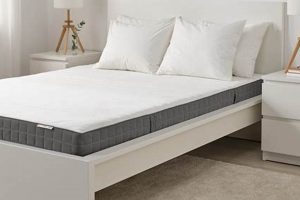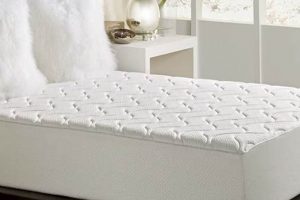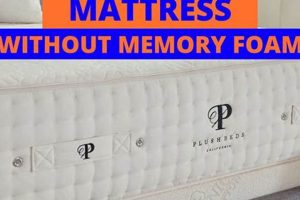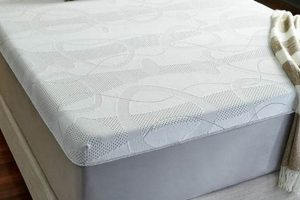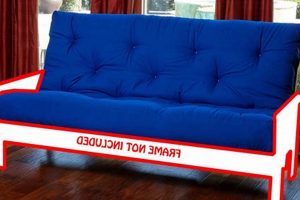An extra-large sleeping surface that contours to the body using viscoelastic foam is a popular choice for individuals and couples prioritizing spaciousness and pressure relief during sleep. These beds typically measure 72 inches wide by 84 inches long, offering additional legroom compared to standard king-sized options. The specific foam construction aims to distribute weight evenly, minimizing motion transfer and promoting spinal alignment.
The appeal of these sleep systems lies in their ability to accommodate various sleep preferences and body types. The expansive dimensions are particularly beneficial for taller individuals or those who share a bed with a partner, children, or pets. Furthermore, the conforming properties of the foam contribute to a reduction in pressure points, potentially alleviating discomfort associated with conditions like back pain or arthritis. The evolution of this bedding technology reflects a growing demand for personalized comfort and enhanced sleep quality.
Subsequent discussions will delve into the factors influencing the selection process, encompassing aspects such as foam density, firmness levels, cooling technologies, and budgetary considerations. A detailed analysis of these elements will empower consumers to make informed decisions when evaluating available options and optimizing their sleep environment.
California King Memory Foam Mattress
Selecting the optimal sleep surface requires careful evaluation of various factors. This section provides key considerations to ensure a purchase aligns with individual needs and preferences.
Tip 1: Prioritize Density. Foam density directly impacts durability and support. Higher density foams generally offer increased longevity and resistance to body impressions, while lower density options may be more susceptible to degradation over time.
Tip 2: Evaluate Firmness. Firmness is subjective but crucial for spinal alignment. Side sleepers often benefit from softer surfaces that contour to the shoulders and hips, while back and stomach sleepers may require firmer support to prevent excessive sinking.
Tip 3: Consider Cooling Technology. Memory foam is known for retaining heat. Look for mattresses incorporating gel infusions, open-cell structures, or breathable covers to mitigate heat buildup and promote a cooler sleep environment.
Tip 4: Assess Motion Isolation. Couples sharing a bed should prioritize motion isolation. Higher quality memory foam effectively absorbs movement, minimizing disturbance to a sleeping partner.
Tip 5: Research Certifications. Certifications such as CertiPUR-US ensure the foam has been independently tested for harmful substances, promoting a healthier sleep environment.
Tip 6: Account for Base Support. The foundation upon which the mattress rests significantly impacts its performance. Ensure the existing bed frame or foundation provides adequate support to prevent sagging and premature wear.
Tip 7: Review Trial Periods and Warranties. A generous trial period allows for in-home testing and evaluation. A comprehensive warranty provides protection against manufacturing defects and premature degradation.
Adhering to these guidelines contributes to a more informed decision, ultimately leading to a more comfortable and supportive sleep experience. The subsequent sections will elaborate on specific materials and construction techniques employed in the creation of these sleep systems.
This detailed exploration of factors influencing the selection of an extra-large viscoelastic foam bed will guide consumers in making the best decision for their needs.
1. Spacious dimensions
The defining characteristic of a California king memory foam mattress is its expansive surface area. Measuring 72 inches wide and 84 inches long, it exceeds the length of a standard king mattress while maintaining a slightly narrower width. These dimensions are not arbitrary; they cater specifically to individuals and couples who require additional legroom or prefer a greater distance from their sleeping partner. The practical consequence of these spacious dimensions is enhanced comfort, particularly for taller individuals who might otherwise find their feet extending beyond the edge of a standard mattress. For couples, the extra width and length translate to reduced motion transfer and minimized feelings of confinement, promoting more restful sleep.
The increased surface area provides tangible benefits beyond mere physical space. A larger mattress allows for greater freedom of movement during sleep. Individuals can change positions without disturbing a partner or feeling restricted by the bed’s edges. This increased mobility can be particularly important for those with conditions that necessitate frequent repositioning during the night. Furthermore, the extra space can be a valuable asset for families with young children or pets who occasionally share the bed. The larger dimensions provide a more comfortable and accommodating environment for all occupants.
In summary, the spacious dimensions are fundamental to the value proposition of a California king memory foam mattress. They directly address the needs of taller individuals, couples seeking minimal disturbance, and those requiring increased freedom of movement. While other factors such as foam density and firmness are also important, the expansive dimensions are the primary differentiator, defining the experience and advantages associated with this particular mattress size. This understanding is crucial for consumers to make informed purchasing decisions that align with their unique sleep requirements and preferences.
2. Pressure relief
The selection of a viscoelastic foam sleep surface is often predicated on its capacity to alleviate pressure points. This attribute is particularly significant in the context of a California king mattress, given its expansive dimensions and potential to accommodate multiple individuals with varying physical characteristics and sleeping positions.
- Conforming Properties of Viscoelastic Foam
The defining characteristic of memory foam is its ability to conform to the contours of the body. This adaptability allows the material to distribute weight evenly across the sleeping surface, reducing concentrated pressure on prominent areas such as the shoulders, hips, and knees. The degree of conformity varies depending on the foam’s density and firmness, requiring careful consideration based on individual preferences and body types.
- Impact on Spinal Alignment
Proper spinal alignment is crucial for minimizing back pain and promoting restful sleep. A mattress that effectively relieves pressure points allows the spine to maintain its natural curvature, reducing strain on supporting muscles and ligaments. A California king size provi
des ample space to achieve this alignment, particularly for individuals who change positions frequently during the night. - Benefits for Individuals with Specific Conditions
The pressure-relieving properties of memory foam mattresses are often cited as a benefit for individuals suffering from conditions such as arthritis, fibromyalgia, and sciatica. By minimizing pressure on sensitive joints and nerves, these mattresses can contribute to a reduction in pain and discomfort, facilitating improved sleep quality. The California king size further enhances this benefit by allowing for unrestricted movement and customized positioning.
- Influence of Foam Density and ILD Rating
The density of the memory foam directly affects its ability to provide long-term pressure relief. Higher density foams generally exhibit greater resilience and resistance to compression, maintaining their conforming properties over time. The Indentation Load Deflection (ILD) rating, also known as firmness, is another important factor. Individuals with higher body weights may require firmer foams to prevent excessive sinking, which can compromise spinal alignment and negate the pressure-relieving benefits.
In conclusion, the pressure-relieving characteristics of viscoelastic foam are intrinsically linked to the advantages offered by a California king mattress. The combination of conforming materials and ample space creates an environment conducive to reduced pain, improved spinal alignment, and enhanced sleep quality. The long-term effectiveness of pressure relief is contingent upon selecting a foam density and firmness that align with individual physical characteristics and sleep preferences.
3. Motion isolation
The significant benefit derived from combining a California king size with viscoelastic foam is the enhancement of motion isolation. The inherent properties of memory foam minimize the transfer of movement across the sleep surface. This is particularly relevant in a larger mattress, as it is often shared by multiple individuals or individuals with varying sleep patterns. The sprawling dimensions inherently increase the potential for disturbance, making effective motion isolation a critical attribute. Real-world examples include couples where one partner experiences restless sleep, frequently changing positions, or where one partner gets up earlier than the other. Without adequate motion isolation, these movements can easily transmit across the mattress, disrupting the sleep of the other individual. The practical significance of understanding this connection lies in the ability to make informed purchasing decisions based on specific needs. Individuals prioritizing uninterrupted sleep, particularly in shared sleeping arrangements, should consider the motion isolation capabilities of a California king memory foam option.
The mechanism behind motion isolation stems from the foam’s ability to absorb energy. When pressure is applied to one area of the mattress, the surrounding foam compresses and conforms to the body’s shape. This process effectively dampens the transmission of movement to other areas of the mattress. Furthermore, the density and composition of the memory foam influence its motion isolation capabilities. Higher density foams generally exhibit superior motion isolation properties compared to lower density foams. Layering different types of foam, such as a high-density base layer and a softer top layer, can also optimize motion isolation performance. The arrangement of materials in the mattress is therefore key. Different construction method, such as pocketed coils for a hybrid mattress, will further enhance motion isolation.
In conclusion, the coupling of viscoelastic foam and California king dimensions presents a compelling solution for individuals seeking to minimize sleep disturbances caused by partner movement. The inherent energy-absorbing properties of memory foam, combined with the increased space afforded by the larger mattress size, contribute to enhanced motion isolation. Selecting a product with appropriate density and layering configuration is paramount to maximizing these benefits. The challenges center around identifying products with verified motion isolation performance through independent testing and understanding the role of underlying support structure in achieving optimal results.
4. Temperature regulation
Temperature regulation represents a significant consideration in the design and selection of a California king memory foam mattress. The inherent properties of viscoelastic foam, while advantageous for pressure relief and motion isolation, can also contribute to heat retention, impacting sleep quality and overall comfort. Therefore, manufacturers and consumers must address this characteristic to optimize the sleep experience.
- Density and Airflow
The density of the memory foam directly influences its thermal properties. Higher density foams, while providing enhanced support and durability, tend to restrict airflow, trapping heat within the mattress. This can lead to a buildup of body heat, causing discomfort and potentially disrupting sleep. Conversely, lower density foams may offer improved airflow but may compromise support and longevity. Manufacturers often employ strategies such as open-cell structures and ventilation channels to mitigate this effect, promoting better heat dissipation and airflow within the mattress core. However, these design features must be carefully balanced with the desired level of support and pressure relief.
- Material Composition
The materials used in the construction of the mattress, beyond the memory foam itself, play a crucial role in temperature regulation. Mattress covers made from breathable fabrics like cotton, Tencel, or bamboo can enhance airflow and wick away moisture, reducing heat buildup on the sleep surface. Additionally, some mattresses incorporate cooling gels or phase-change materials (PCMs) within the memory foam layer. These PCMs absorb and release heat, helping to regulate temperature and maintain a comfortable sleep environment. The effectiveness of these materials depends on their concentration and distribution within the mattress, as well as the overall design and construction.
- Environmental Factors
External environmental conditions also significantly influence temperature regulation in a viscoelastic foam mattress. Room temperature, humidity levels, and bedding materials can either exacerbate or mitigate heat retention. A well-ventilated bedroom with a controlled temperature and humidity level can enhance the effectiveness of cooling technologies incorporated within the mattress. Conversely, using heavy blankets or non-breathable bedding materials can negate these benefits, trapping heat and increasing discomfort. Therefore, optimizing the sleep environment is crucial for achieving optimal temperature regulation and maximizing the benefits of a California king memory foam mattress.
- Individual Physiology
Individual physiological factors, such as metabolic rate, body weight, and sleepwear choices, influence heat generation and perception during sleep. Individuals with higher metabolic rates or body weights tend to generate more heat, potentially exacerbating heat retention issues within a memory foam mattress. Similarly, the type of sleepwear worn can affect airflow and moisture wi
cking, impacting overall comfort. Selecting lightweight, breathable sleepwear and adjusting bedding layers to accommodate individual temperature preferences are important strategies for optimizing temperature regulation. Furthermore, individuals with specific medical conditions, such as night sweats or hot flashes, may require specialized cooling technologies or mattress designs to manage temperature effectively.
In summary, the successful integration of temperature regulation mechanisms within a California king memory foam mattress requires a holistic approach, considering material composition, mattress design, environmental conditions, and individual physiology. A careful balance between these factors is essential for optimizing sleep quality and maximizing the benefits of viscoelastic foam technology.
5. Density variations
Density variations within a California king memory foam mattress are directly correlated to its performance characteristics, influencing support, durability, and overall comfort. The term “density” refers to the weight of the foam per cubic foot, typically measured in pounds (lbs). A higher density indicates a greater amount of material packed into the same volume, resulting in a firmer and more resilient structure. This impacts the mattress’s ability to distribute weight evenly and resist compression over time. For example, a California king mattress with high-density foam (5 lbs or greater) is likely to provide superior support for heavier individuals or those who prefer a firmer sleeping surface. Conversely, a lower density foam (3 lbs or less) may feel softer initially but is more prone to sagging and loss of support, particularly under sustained pressure.
The practical significance of understanding density variations lies in aligning mattress selection with individual needs and preferences. A mattress with a multi-layered construction might incorporate different densities of foam in different zones to achieve targeted support and pressure relief. For instance, a firmer, high-density foam in the core can provide foundational support, while a softer, lower-density foam in the comfort layer can contour to the body and alleviate pressure points. This nuanced approach allows manufacturers to tailor the sleeping experience to a wider range of body types and sleep positions. Furthermore, density is a critical factor in determining the longevity of the mattress. Higher density foams generally exhibit greater resistance to degradation, maintaining their shape and support for a longer period compared to lower density alternatives. This is particularly relevant for a larger mattress like a California king, which is subject to greater weight distribution and potential for wear and tear. Understanding density is essential when considering the long-term value and performance of the product.
In conclusion, density variations represent a fundamental aspect of California king memory foam mattress design. The choice of foam density directly affects support, comfort, and durability, impacting the overall sleep experience. While higher density foams typically offer greater support and longevity, lower density options may provide a softer feel. A strategically designed mattress can utilize varying densities in different layers to achieve optimal performance characteristics tailored to specific needs. Consumers who understand the role of density variations are better equipped to evaluate and select a mattress that aligns with their individual preferences and long-term expectations, avoiding the pitfalls of prioritizing initial comfort over long-term support and durability.
6. Support longevity
Support longevity, in the context of a California king memory foam mattress, refers to the ability of the mattress to maintain its original support characteristics over an extended period of use. This is a critical factor, as the initial comfort and pressure relief offered by a new mattress can diminish significantly if the materials degrade or lose their structural integrity prematurely. Evaluating support longevity is essential for ensuring long-term satisfaction and value.
- Material Density and Degradation
The density of the memory foam core directly influences its resistance to degradation. Higher-density foams generally exhibit greater resilience and are less prone to compression and sagging over time. Lower-density foams, while potentially providing a softer initial feel, tend to break down more quickly, leading to a loss of support and the formation of body impressions. The selection of appropriate density is therefore crucial for maximizing support longevity. As an example, a mattress with a 5 lb/cubic foot density rating will typically offer superior long-term support compared to a mattress with a 3 lb/cubic foot rating.
- Construction and Layering Techniques
The construction techniques employed in assembling the mattress significantly impact its ability to retain support. Well-constructed mattresses often incorporate multiple layers of foam with varying densities and firmness levels to distribute weight and minimize stress on individual layers. Additionally, features such as reinforced edges and durable support cores can enhance the mattress’s structural integrity and prevent sagging. A mattress utilizing a high-density foam base layer combined with a progressive layering system can extend its support lifespan substantially.
- Foundation Compatibility
The type of foundation used with a California king memory foam mattress can either contribute to or detract from its support longevity. An inadequate or poorly supported foundation can place undue stress on the mattress, accelerating its degradation and reducing its lifespan. Solid platforms or foundations with closely spaced slats provide optimal support, distributing weight evenly across the mattress surface. Conversely, foundations with widely spaced slats or flexible springs can lead to sagging and uneven wear. Utilizing a compatible and supportive foundation is essential for preserving the mattress’s original support characteristics.
- Warranty and Usage Patterns
The warranty provided by the manufacturer serves as an indicator of their confidence in the mattress’s support longevity. Longer warranties often reflect the use of higher-quality materials and construction techniques. However, usage patterns also play a significant role. Excessive weight, improper care, and failure to rotate or flip the mattress (if applicable) can shorten its lifespan and compromise its support characteristics. Adhering to the manufacturer’s recommendations for care and maintenance is crucial for maximizing support longevity.
In conclusion, support longevity is a multi-faceted attribute of a California king memory foam mattress, influenced by material density, construction techniques, foundation compatibility, and usage patterns. Assessing these factors is crucial for making informed purchasing decisions and ensuring long-term satisfaction with the product. The trade-offs between initial comfort, long-term support, and overall durability must be carefully considered to select a mattress that meets individual needs and expectations.
Frequently Asked Questions
This section addresses common inquiries and concerns regarding extra-large viscoelastic foam beds. Information presented aims to provide clarity and assist in making informed purchasing decision
s.
Question 1: What are the standard dimensions of a California king memory foam mattress?
The dimensions are typically 72 inches in width and 84 inches in length. These dimensions cater to individuals requiring additional length compared to a standard king-size mattress.
Question 2: How does foam density affect the performance of this type of mattress?
Foam density significantly influences support, durability, and motion isolation. Higher density foams generally offer greater support and longevity, while lower density foams may provide a softer initial feel but may degrade more quickly.
Question 3: What are the primary advantages of a California king memory foam mattress compared to other mattress types?
The key advantages include increased surface area for spaciousness, pressure relief due to the conforming properties of memory foam, and reduced motion transfer, minimizing sleep disturbances.
Question 4: Are there any specific considerations regarding temperature regulation with memory foam mattresses?
Viscoelastic foam can retain heat. Mattresses incorporating cooling technologies such as gel infusions, open-cell structures, or breathable covers are recommended to mitigate heat buildup.
Question 5: What type of foundation is most suitable for a California king memory foam mattress?
A solid platform or a foundation with closely spaced slats is recommended. This provides adequate support and prevents sagging, ensuring the mattress maintains its structural integrity.
Question 6: How should the lifespan of a California king memory foam mattress be maximized?
Following manufacturer recommendations for care and maintenance is crucial. This includes using a compatible foundation, rotating the mattress periodically (if applicable), and avoiding excessive weight or pressure in specific areas.
Understanding these aspects promotes well-informed decisions and facilitates long-term satisfaction with viscoelastic foam bedding.
The following sections will provide insights into the construction materials and technologies associated with these sleep systems.
Conclusion
This discourse has methodically examined the defining attributes of the California king memory foam mattress. It has delved into the significance of expansive dimensions, pressure-relieving capabilities, and motion isolation effectiveness. Further, it addressed the crucial aspect of temperature regulation, emphasizing the interplay between foam density, material composition, and environmental factors. The analysis extended to variations in density and their consequential effects on support, longevity, and overall comfort. The importance of long-term support and strategies for maximizing mattress lifespan were also scrutinized.
The information presented provides a foundation for informed decision-making. Prospective purchasers are urged to carefully consider individual requirements, prioritize factors such as density, firmness, and cooling technologies, and thoroughly evaluate warranty terms and trial periods. The selection of a sleep surface warrants judicious assessment, ensuring a purchase aligns with long-term health and well-being.


